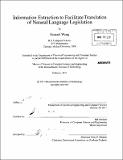Information extraction to facilitate translation of natural language legislation
Author(s)
Wang, Samuel (Samuel Siyue)
DownloadFull printable version (3.208Mb)
Other Contributors
Massachusetts Institute of Technology. Dept. of Electrical Engineering and Computer Science.
Advisor
Hal Abelson.
Terms of use
Metadata
Show full item recordAbstract
There is a large body of existing legislation and policies that govern how government organizations and corporations can share information. Since these rules are generally expressed in natural language, it is difficult and labor intensive to verify whether or not data sharing events are compliant with the relevant policies. This work aims to develop a natural language processing framework that automates significant portions of this translation process, so legal policies are more accessible to existing automated reasoning systems. Even though these laws are expressed in natural language, for this very specific domain, only a handful of sentence structures are actually used to convey logic. This structure can be exploited so that the program can automatically detect who the actor, action, object, and conditions are for each rule. In addition, once the structure of a rule is identified, similar rules can be presented to the user. If integrated into an authoring environment, this will allow the user to reuse previously translated rules as templates to translate novel rules more easily, independent of the target language for translation. A body of 315 real-world rules from 12 legal sources was collected and annotated for this project. Cross-validation experiments were conducted on this annotated data set, and the developed system was successful in identifying the underlying rule structure 43% of the time, and annotating the underlying tokens with recall of .66 and precision of .66. In addition, for 70% of the rules in each test set, the underlying rule structure had been seen in the training set. This suggests that the hypothesis that rules can only be expressed in a limited number of ways is probable.
Description
Thesis (S.M.)--Massachusetts Institute of Technology, Dept. of Electrical Engineering and Computer Science, 2011. Cataloged from PDF version of thesis. Includes bibliographical references (p. 65-66).
Date issued
2011Department
Massachusetts Institute of Technology. Department of Electrical Engineering and Computer SciencePublisher
Massachusetts Institute of Technology
Keywords
Electrical Engineering and Computer Science.